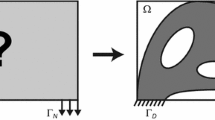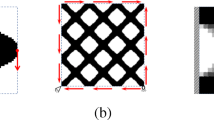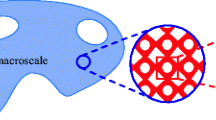Abstract
The integration of additive manufacturing and topology optimization makes it possible to fabricate complex configurations, especially for microscale structures, which can guarantee the realization of high-performance structural designs. However, topology results often contain microstructures (several multicellular scales) similar to the characteristic length of local macrostructures, leading to errors in structural performance analysis based on classical theories. Therefore, it is necessary to consider the size effect in topology optimization. In this paper, we establish a novel topology optimization model utilizing the integral nonlocal theory to account for the size effect. The approach consists of an integral constitutive model that incorporates a kernel function, enabling the description of stress at a specific point in relation to strain in a distant field. Topology optimization structures based on nonlocal theory are presented for some benchmark examples, and the results are compared with those based on classical medium theory. The material layout exhibits significant differences between the two approaches, highlighting the necessity of topology optimization based on nonlocal theory and the effectiveness of the proposed method.










Similar content being viewed by others
Availability of Data and Materials
The datasets generated or analyzed during this study are available from the corresponding author upon reasonable request.
References
Wang X, Xu S, Zhou S, Xu W, Leary M, Choong P, et al. Topological design and additive manufacturing of porous metals for bone scaffolds and orthopaedic implants: a review. Biomaterials. 2016;83:127–41.
Schaedler TA, Jacobsen AJ, Torrents A, Sorensen AE, Lian J, Greer JR, et al. Ultralight metallic microlattices. Science. 2011;334(6058):962–5.
Prathyusha ALR, Raghu BG. A review on additive manufacturing and topology optimization process for weight reduction studies in various industrial applications. Mater Today Proc. 2022;62:109–17.
Liu S, Li Q, Liu J, Chen W, Zhang Y. A realization method for transforming a topology optimization design into additive manufacturing structures. Engineering. 2018;4(2):277–85.
Bendsøe MP, Kikuchi N. Generating optimal topologies in structural design using a homogenization method. Comput Methods Appl Mech Eng. 1988;71(2):197–224.
Liu L, Yan J, Cheng G. Structure-Material concurrent optimization considering uniform material microstructure. Chin J Comput Mech. 2008;25(1):29–34.
Bažant ZP. Size effect. Int J Solids Struct. 2000;37(1–2):69–80.
Gu XW, Loynachan CN, Wu Z, Zhang YW, Srolovitz DJ, Greer JR. Size-dependent deformation of nanocrystalline Pt nanopillars. Nano Lett. 2012;12(12):6385–92.
Sun Q, Guo Q, Yao X, Xiao L, Greer JR, Sun J. Size effects in strength and plasticity of single-crystalline titanium micropillars with prismatic slip orientation. Scr Mater. 2011;65(6):473–6.
Liu S, Su W. Effective couple-stress continuum model of cellular solids and size effects analysis. Int J Solids Struct. 2009;46(14–15):2787–99.
Da D, Yvonnet J, Xia L, Le MV, Li G. Topology optimization of periodic lattice structures taking into account strain gradient. Comput Struct. 2018;210:28–40.
Li L, Zhang G, Khandelwal K. Topology optimization of structures with gradient elastic material. Struct Multidiscip Optim. 2017;56(2):371–90.
Eringen AC, Edelen DGB. On nonlocal elasticity. Int J Eng Sci. 1972;10(3):233–48.
Fernández-Sáez J, Zaera R, Loya JA, Reddy JN. Bending of Euler-Bernoulli beams using Eringen’s integral formulation: a paradox resolved. Int J Eng Sci. 2016;99:107–16.
Polizzotto C. Nonlocal elasticity and related variational principles. Int J Solids Struct. 2001;38(42):7359–80.
Polizzotto C, Fuschi P, Pisano AA. A strain-difference-based nonlocal elasticity model. Int J Solids Struct. 2004;41(9–10):2383–401.
Polizzotto C, Fuschi P, Pisano AA. A nonhomogeneous nonlocal elasticity model. Eur J Mech A Solids. 2006;25(2):308–33.
Pisano AA, Sofi A, Fuschi P. Nonlocal integral elasticity: 2D finite element based solutions. Int J Solids Struct. 2009;46(21):3836–49.
Pisano AA, Sofi A, Fuschi P. Finite element solutions for nonhomogeneous nonlocal elastic problems. Mech Res Commun. 2009;36(7):755–61.
Fuschi P, Pisano AA, De Domenico D. Plane stress problems in nonlocal elasticity: finite element solutions with a strain-difference-based formulation. J Math Anal Appl. 2015;431(2):714–36.
Ghosh S, Kumar A, Stindararaghavan V, Waas AM. Non-local modeling of epoxy using an atomistically-informed kernel. Int J Solids Struct. 2013;50(19):2837–45.
Sundararaghavan V, Waas A. Non-local continuum modeling of carbon nanotubes: physical interpretation of non-local kernels using atomistic simulations. J Mech Phys Solids. 2011;59(6):1191–203.
Andreassen E, Clausen A, Schevenels M, Lazarov BS, Sigmund O. Efficient topology optimization in MATLAB using 88 lines of code. Struct Multidiscip Optim. 2010;43(1):1–16.
Sigmund O, Maute K. Sensitivity filtering from a continuum mechanics perspective. Struct Multidiscip Optim. 2012;46(4):471–5.
Acknowledgements
The authors gratefully acknowledge the financial support to this work by the National Natural Science Foundation of China (Grant Nos. 12272076 and 11802164) and the 111 Project (B14013).
Author information
Authors and Affiliations
Contributions
JL provided all the data for this paper and contributed significantly to writing this paper. SL conceived the main idea of this paper and put forward valuable suggestions for revision. QL provided the large memory server needed for the calculation and modified the English.
Corresponding author
Ethics declarations
Competing interests
The authors declare that they have no conflicts of interest.
Consent for Publication
All authors have approved the final manuscript and its submission to the journal.
Rights and permissions
Springer Nature or its licensor (e.g. a society or other partner) holds exclusive rights to this article under a publishing agreement with the author(s) or other rightsholder(s); author self-archiving of the accepted manuscript version of this article is solely governed by the terms of such publishing agreement and applicable law.
About this article
Cite this article
Li, J., Li, Q. & Liu, S. Topology Optimization Method for Microscale Structures Described with Integral Nonlocal Theory. Acta Mech. Solida Sin. 37, 63–71 (2024). https://doi.org/10.1007/s10338-023-00438-4
Received:
Revised:
Accepted:
Published:
Issue Date:
DOI: https://doi.org/10.1007/s10338-023-00438-4




